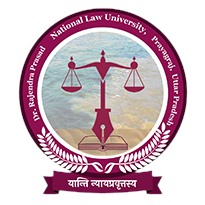डॉ राजेन्द्र प्रसाद
राष्ट्रीय विधि विश्वविद्यालय प्रयागराज



यान्ति न्यायप्रवृत्तस्य:
यान्ति न्यायप्रवृत्तस्य का शाब्दिक अर्थ है ‘न्याय मार्ग पर चलने वाला’ (the literal meaning of the phrase is – The One who is engaged in a virtuous way of life).
The complete Shloka from Ramayana is as follow-
यान्ति न्यायप्रवृत्तस्य तिर्यङ्कोऽपि सहायताम् । अपन्थानं तु गच्छन्तं सोदरोऽपि विमुञ्चति ॥
One who is engaged in a virtuous way of life, even lowly animals comes forward to provide assistance. On the other hand, if a person is engaged in the immoral way of life, his brother even will abandon him.
Laurel Leaves
Laurel leaves in the logo hold profound significance, symbolizing victory, achievement, and honour. Their classical and timeless aesthetics convey stability and longevity, appealing to brands seeking a sense of tradition. Laurel leaves evoke attributes of leadership and authority. Additionally, their natural and organic connotations contribute to logos suggesting eco-friendliness or adaptability. The laurel’s versatility allows institutions’ success, prestige, and quality, creating a visual emblem that transcends time and resonates with diverse audiences. The symbol of the laurel can mean the hopeful expectation of success in the search for the True Word.
Balance of Justice on a Pen
The pen and justice balance in a law institution’s logo carries profound symbolism. The pen signifies the knowledge and documentation integral to the legal profession, embodying authority and professionalism. Meanwhile, the justice balance, or scales, represents fairness, equality, and impartiality in legal proceedings. Together, these symbols encapsulate meticulous legal knowledge, the pursuit of accuracy, and the commitment to legal pursuit. The combination of balance standing on a pen in a logo communicates a dedication to upholding the law education with precision, ensuring that legal processes are conducted with objectivity and integrity, and emphasizing the institution’s role in fostering a system rooted in justice and equality. It underscores the pivotal role of the rule of law, emphasizing that legal decisions should derive from established principles rather than arbitrary judgments. Furthermore, placing the justice balance on a pen amplifies the significance of legal documentation, symbolizing the power of the Constitution, contracts, and the creation of laws.
Additionally, the juxtaposition of traditional symbols with the pen also suggests RPNLUP vision of openness to innovation, acknowledging the evolving nature of law. Ultimately, the symbol encapsulates a multifaceted representation of justice, legal authority, educational commitment, and adaptability within the legal profession.
Book
Including a book in RPNLUP emblem symbolizes a commitment to knowledge, learning, and academic excellence. It signifies the University’s dedication to providing a high-quality, well-rounded education. The book may also represent tradition, reflecting the University’s historical roots and commitment to established academic principles. Additionally, it conveys the diversity of disciplines offered, showcasing a comprehensive educational experience. Whether suggesting research and innovation or emphasizing effective communication, the book in the logo communicates the University’s values and mission. The design choice reflects the institution’s professionalism and underscores its role in fostering intellectual growth and the exchange of ideas.
Confluence of Ganga and Yamuna Rivers:
The confluence of Knowledge and Justice mirrors the merging of two rivers, blending the depth of understanding with the structured foundation of regulations. The University is situated in the holy city of Prayagraj which has been a seat of learning. This intersection symbolizes a unified force where accumulated wisdom informs legal principles, creating a dynamic and comprehensive approach to societal challenges. Like the fertile ecosystem that emerges at the confluence of rivers, the synergy of Knowledge and Justice cultivates holistic problem-solving.
In this symbiotic relationship, Knowledge serves as the fertile soil from which legal principles grow, facilitating informed decision-making. The combination ensures that decisions are not only wise but also grounded in established rules, enhancing their legitimacy. The confluence fosters adaptability, allowing the legal education to navigate changing landscapes and stay resilient in the face of evolving challenges. Much like the diverse ecosystem nurtured by converging rivers, the integration of knowledge and Justice establishes a rich educational and legal environment.